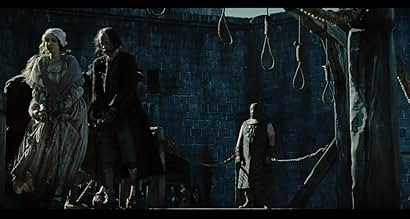Pirates of the Caribbean: At World’s End - A Triumphant Return to Form
The latest installment in the “Pirates of the Caribbean” franchise is nothing short of amazing, surpassing its summer blockbuster competitors in terms of sheer emotional impact. “Pirates of the Caribbean: At World’s End” crams so much action and plot into its nearly three-hour runtime that even a brief summary would be lengthy. It’s a pure celebration – a rare opportunity to abandon all pretense, age, and status, and wholeheartedly laugh at the simplest jokes while marveling at the incredible special effects with childlike wonder.
A Dark Overture
The film opens with a grim scene: an endless procession of ragged individuals of all ages and backgrounds being led to the gallows. Lord Cutler Beckett (Tom Hollander) has declared a state of emergency in the Caribbean, systematically dismantling democratic freedoms, abolishing basic civil rights, and ordering the execution of anyone even remotely connected to pirates. Or connected to those connected to pirates. Or connected to those connected to those connected to pirates, and so on, ad infinitum.
However, a young boy with a noose around his neck begins to sing an old pirate song, which is quickly taken up by all the condemned. This signals that it’s time for the pirates to unite and rebel, and for the nine pirate lords to convene. But before these notorious figures can make a decision, they must rescue Captain Jack Sparrow (Johnny Depp) from the afterlife. The pirate community, it seems, is incomplete without him. Thus, a motley crew consisting of Will Turner (Orlando Bloom), his fiancée Elizabeth Swann (Keira Knightley), and the unexpectedly resurrected Captain Barbossa (Geoffrey Rush), enlists the help of Singaporean pirate lord Sao Feng (Chow Yun-Fat) and embarks on a rescue mission.
The Eccentric Return of Captain Jack
Of course, Jack Sparrow is eventually found. But first, his enormous, sniffing nose dominates the screen (a close-up comparable in impact to Donatas Banionis’ ear in “Solaris” (1972)).
Jack’s time in captivity has clearly taken a toll on his already unstable psyche. Within the first three minutes of his appearance, he manages to fight himself over a peanut, make amorous advances toward a hallucinated goat, and even lay an egg. However, he soon regains his composure (as much as is possible for him) and plunges headfirst into a whirlwind of intricate plots. The bargaining chips include an ancient and invaluable map, ritual objects used to summon the sea goddess Calypso, the chest containing the heart of Davy Jones (Bill Nighy), captain of the Flying Dutchman, and the beautiful Elizabeth – a woman on board a ship, traditionally seen as both a harbinger of misfortune and a highly sought-after commodity.

A Spectacle of Epic Proportions
The film is packed with so many events (both explaining past occurrences and introducing entirely new and unexpected twists) that even a brief summary would be far too long. It’s best to go in without knowing too much, as any self-respecting moviegoer should experience it firsthand. Missing the third installment of “Pirates,” subtitled “At World’s End,” is only justifiable under threat of execution – and even then, it’s worth reconsidering. The previous film in the unexpectedly triumphant series, “Pirates of the Caribbean: Dead Man’s Chest” (2006), was technically proficient but lacked the distilled delight of the original, “Pirates of the Caribbean: The Curse of the Black Pearl” (2003). Now, everything is back on track. The new film is exceptional in every way, emotionally outperforming its summer blockbuster rivals. Neither the latest “Spider-Man” nor another “Shrek” offers even a fraction of the joy found in this “merry chronicle of a dangerous journey.” It’s a true celebration – a rare opportunity to forget about propriety, age, and status, and laugh heartily at the simplest jokes (surprisingly, even the most overused comedic tropes work in “Pirates,” such as the scene where a fragile girl is revealed to be carrying far more weapons than expected, or when a menacing giant suddenly speaks in a high-pitched voice) and, with childlike wonder, behold the incredible special effects.
The climactic battle between the Black Pearl and the Flying Dutchman on the edge of a swirling vortex is unparalleled – arguably the most significant battle scene in world cinema in recent memory. Occasionally, the brain disengages from the spectacle and attempts to analyze the events objectively. But even here, “Pirates” holds up, revealing fascinating nuances. Director Gore Verbinski continues to subtly infuse his outstanding trilogy with occult and esoteric elements. While the previous film clearly paid homage to the unsettling worlds of H.P. Lovecraft (Davy Jones, with his tentacled face reminiscent of Cthulhu, the crew of the Flying Dutchman consisting of fish-people, and other “shadows over Innsmouth”), this time, as the travelers enter the snowy world of Jones’s “secret place,” where up is down and a mystical green ray shines at dawn, Edgar Allan Poe’s “The Narrative of Arthur Gordon Pym of Nantucket” and the corresponding dark tales of Jean Ray come to mind.

However, one can choose to ignore these elements. The most important thing is the unparalleled ecstasy that each frame of this remarkable work evokes. Despite the obvious commercial motivations behind the project, the viewer never feels like they’ve been lured into the theater for the third time to see essentially the same thing, just to extract more money from their wallets. While the money will undoubtedly be made, in this case, you pay for the ticket with a clear conscience and sincere gratitude. It seems that somewhere in the Disney vaults, there truly is a barnacle-encrusted chest containing something big and good, and its steady beat transforms a big-budget spectacle into your own long-awaited and truly joyful celebration, like an extra birthday.
Just don’t stumble halfway there, dear heart.
